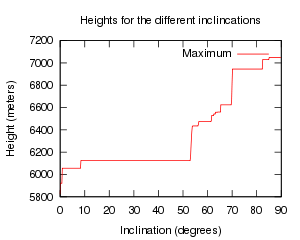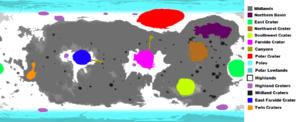Difference between revisions of "Mun/ja"
Kspjptrans (talk | contribs) (→Terrain) |
Kspjptrans (talk | contribs) (→地勢) |
||
| Line 37: | Line 37: | ||
|description= | |description= | ||
|content= | |content= | ||
| − | * | + | * 大きな石のアーチが3つある。その大きさから赤道付近を高度10000m以下で周回していれば容易に発見できる。 |
| − | * | + | * 人類最初の月面着陸者Neil Armstrongの記念碑が建っている。 It can be found inside one of the largest craters, near the south wall. この場所はアポロ11号が月に着陸した地点とほぼ一致している。低軌道から白い点として微かに視認できる。 |
| − | * | + | * モノリス(捩ってMunolithとも)が3つある。モノリスは小さく、発見するのは非常に難しい。ひとつは地中に、残り2つはそれぞれ非常に深い縦穴の中にある。 |
* There are several other secrets on the Mun for the dedicated observer. Look around! | * There are several other secrets on the Mun for the dedicated observer. Look around! | ||
}} | }} | ||
Revision as of 22:42, 4 September 2014
Munは時にはMünとも表記される、Kerbin周回軌道上にある比較的大きな衛星である。現実宇宙における月の類似物で、しばしば“月”(ラテン語でLuna)とそのまま呼ばれる。
地表は灰色で、大小様々なクレーターと標高5029mを超える山岳が存在する。表面重力は1.63 m/s²でKerbinと比較するとおよそ1/6で8.18 m/s²の差がある。ちなみに現実の月の表面重力は1.624 m/s²である。Munに着陸できるのはもちろん、重力アシスト(スイングバイ)としてMinmusやKerbolなどより遠い天体へ向かう軌道に乗ることにも活用できる。 though such maneuvers do not save very much fuel and are more imprecise. It is, however, useful for plane changes with proper timing.
新規プレイヤーはMun(ほか大多数の天体)には大気が存在しないことに注意すべきだ。これはパラシュートが地表への着陸手段として使えないことを意味している。
There are anomalous geological formations that can be found on the surface of the Mun. To preserve the enjoyment of exploration for new players, those who have found these sites are encouraged to keep their exact coordinates secret.
Munの同期軌道は高度2 970.58 kmにあるが、すでに重力圏外なため維持することは不可能である。However, putting your spacecraft just outside Mun's SOI and having the same semi-major axis would make it appear stationary. 標準的な高度25 kmまで上昇するには800 m/sのdelta Vが必要である。なお準同期軌道は高度約1797.41kmである。
tutorialにて月面旅行を解説している。
Contents
ゲーム内の説明
| 「 | MunはKerbinの周りを回る大きな衛星である。灰色の天体で平坦な一部いがいは大小さまざまなクレーターに覆われている。
Munでの新発見は緑進化の謎を解明する重要な糸口になると広く考えられている。 Granted it didn’t happen all that long ago, but its still fair to say that Kerbals are wiser and more evolved now than they were back then. — Kerbal天文学会 |
」 |
地勢
Munの地形は荒く、灰色で、クレーターがはっきり残っているのが特徴だ。低地は表土がより濃い灰色になる傾向がある。Munにも峡谷が存在しておりその深さは数百m、全長は数kmに及ぶ。
Mun地形の最高高度地点は南極近くの西経152.33°南緯82.52°にあり、7061 m以上の高度がある。この高度では10倍速ワープが可能だが、 allowing crashes with terrain while being in a seemingly stable orbit.最低高度地点は北の大クレーター南西よりの西経76.63°北緯35.32°で高度は-247 mである。
地表の細部要素はグラフィック設定により岩や小石が出現する。他惑星の細部要素と同様にMunの岩なども当たり判定のない装飾で宇宙船や緑が引っかかることはない。
As of 0.21 the Mun is peppered with procedural impact craters making Mun landing more difficult. Previously the lowest point with an altitude of 0 m was on the east side of a large crater, at 35.42° E, 8.27° N.
The Hell Kraken has been encountered on the Mun, with objects being thrown out of Kerbin's sphere of influence upon reloading the craft.
The Mun also has several hidden surprises for explorers to find:
- 大きな石のアーチが3つある。その大きさから赤道付近を高度10000m以下で周回していれば容易に発見できる。
- 人類最初の月面着陸者Neil Armstrongの記念碑が建っている。 It can be found inside one of the largest craters, near the south wall. この場所はアポロ11号が月に着陸した地点とほぼ一致している。低軌道から白い点として微かに視認できる。
- モノリス(捩ってMunolithとも)が3つある。モノリスは小さく、発見するのは非常に難しい。ひとつは地中に、残り2つはそれぞれ非常に深い縦穴の中にある。
- There are several other secrets on the Mun for the dedicated observer. Look around!
Biomes
Currently[outdated], the Mun is one of only three celestial bodies (all members of the Kerbin System) with actual biomes and has, with a total of 15, the most biomes of any celestial body. Each major crater is a distinct biome, which gives them somewhat official names; however, like all biome names, they are fairly generic. The Midlands and Highlands biomes each have a biome applied to any of the nameless large craters within them. The polar regions also have three different biomes.The complete list of Mun biomes is:
- Midlands
- Northern Basin
- East Crater
- Northwest Crater
- Southwest Crater
- Farside Crater
- Canyons
- Polar Crater
- Poles
- Polar Lowlands
- Highlands
- Highland Craters
- Midland Craters
- East Farside Crater
- Twin Craters
Observation from Kerbin
The Mun's orbit keeps it directly above Kerbin's equator. Because the Mun is tidally locked to Kerbin with a perfectly circular, non-inclined orbit, exactly 50% of the Mun's surface (excluding areas on the edge obscured by the Mun's mountains) is ever visible from Kerbin.
Due to the Mun's non-inclined orbit, solar eclipses occur every time the Mun goes between the Sun and Kerbin. Due to graphic engine limitations, these solar eclipses currently do not make the sky black, or darken the land. However, solar panels will become blocked by the Mun in an eclipse and become useless for a short period of time.
Observation of Kerbin
Because Mun is tidally locked to Kerbin, Kerbin is only visible from 50% of the Mun's surface, and Kerbin never sets or rises as seen from the Mun. The Mun longitude for which Kerbin remains directly above in the sky (at the zenith) is about 47 degrees east. The Mun's equator is coplanar with Kerbin's, so any location on the Mun's equator that faces Kerbin will also face Kerbin's equator. Kerbin is not tidally locked to the Mun, so any point on the Mun where Kerbin is not obscured by the Mun's landscape will be able to observe every point on Kerbin as Kerbin rotates. Kerbin's synodic rotational period with the Mun is 25617.909 seconds, or 1.18323 Kerbin solar days.
Science
Although the science-multipliers of Mun's surface and orbit are quite low compared to that of other planets and moons, Mun is comparably easy to reach and has a very large number of biomes which all yield different science results. This makes it - together with Minmus - the main source of science points during the midgame.
Reference Frames
| 時間加速中 | 最低高度 |
|---|---|
| 1× | どこでも |
| 5× | 5 000 m |
| 10× | 5 000 m |
| 50× | 10 000 m |
| 100× | 25 000 m |
| 1 000× | 50 000 m |
| 10 000× | 100 000 m |
| 100 000× | 200 000 m |
Gallery
- Error creating thumbnail: File missing
Four kerbals manning a Mun base
Trivia
- After its implementation, many fans began calling the body Mün, pronounced the same as "moon", believing the original spelling to be a mistake. However, several of the game's developers have been heard referring to it as Mun, pronounced "muhn". In the "Surface of the Mün" title screen, a crashed lander resembling a Kerbal X has the words "Mün or Bust" scrawled on the side. Both spellings are generally accepted, however the spelling in-game is Mun.
- Mun was Kerbin's, and indeed the game's, very first moon.
- Mun's orbit is perfectly circular and has zero orbital inclination. Such an orbit in reality would be very unlikely since this would require precise positioning of any dust/bodies that created it during the planetary system's formation, as well as the absence of a central star or other planets.
- This was likely done to make it easier to reach for new players.
- Prior to バージョン 0.14.2, the tallest points on the munar surface were no higher than roughly 600m.
- Before introduction of procedural terrain the Mun's highest point was within 45° latitude of the equator, had an altitude of 2967 m and was located at 129.64° W, 0.97° N, on the north side of a canyon which was on the east edge of a large crater.
- Prior to バージョン 0.14.3 a KSC could be found on the Mün.
Changes
- New Procedurally generated craters.
- Height values reverted
- Terrain overhaul
- Easter Eggs added (one fixed, one added)
- New small art pass.
- Texture Improvements
- Easter Eggs added
- Texture Improvements
- Removed KSC on it.(don't ask)
- Terrain overhaul
- Initial Release
Notes















